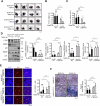Reduction of lymphotoxin beta receptor induces cellular senescence via the MDMX-p53 pathway
- PMID: 40883295
- PMCID: PMC12397326
- DOI: 10.1038/s41420-025-02708-1
Reduction of lymphotoxin beta receptor induces cellular senescence via the MDMX-p53 pathway
Abstract
The lymphotoxin β receptor (LTβR), a key activator of non-canonical NF-κB signaling, is expressed in various cells, including cancer cells. Although high expression of LTβR has been associated with poor patient prognosis and drug resistance, conflicting evidence suggested that LTβR induces apoptosis. To investigate the functional role of LTβR in tumors, we performed LTβR knockdown in cancer cells. We found that LTβR knockdown induced senescence phenomena such as reduced cell number; increased cell size; increased SA-β-Gal activity; and upregulated p53, MDM2 and p21 expression. Moreover, LTβR knockdown induced p21-mediated senescence in p53 WT cancer cells, but not in p53 mutant cancer cells. The level of p53 is regulated by MDM2 and MDMX; MDMX enhances MDM2 activity but is also subject to MDM2-mediated degradation in the nucleus. We found that the intracellular domain of LTβR bound to MDMX thereby inhibited its nuclear translocation, which in turn reduced MDMX ubiquitination and consequently promoted p53 ubiquitination. Additionally, tumors derived from B16F10LTβR-KO cells in WT mice exhibited significantly reduced growth compared to those derived from B16F10WT cells. These results demonstrate that LTβR regulates p53 protein levels by modulating MDMX stability and localization, resulting in p53-mediated cellular senescence. LTβR regulates p53-mediated senescence by inhibiting MDMX nuclear translocation and degradation. LTβR interacts with MDMX in the cytoplasm, preventing its nuclear translocation and degradation under normal conditions (dotted arrows). When LTβR is depleted, MDMX is translocated into the nucleus by MDM2, and undergoes degradation (solid arrows). This reduces p53 degradation and consequently activates p53, leading to p21 transcription and the induction of cellular senescence. Treatment with doxorubicin (Dox) or nutlin-3a further enhances p53-mediated transcriptional activation of p21, and their combination with LTβR depletion exerts an additive effect in promoting cellular senescence.
© 2025. The Author(s).
Conflict of interest statement
Competing interests: The authors declare no competing interests. Ethics approval: All animal procedures were approved by the Institutional Animal Care and Use Committee (IACUC) of Yonsei University College of Medicine (IACUC no. 2023-0146) and were performed in accordance with the Guide for the Care and Use of Laboratory Animals (National Research Council).
Figures








References
-
- Tamada K, Shimozaki K, Chapoval AI, Zhai Y, Su J, Chen SF, et al. LIGHT, a TNF-like molecule, costimulates T cell proliferation and is required for dendritic cell-mediated allogeneic T cell response. J Immunol. 2000;164:4105–10. - PubMed
-
- Chin RK, Zhu M, Christiansen PA, Liu W, Ware C, Peltonen L, et al. Lymphotoxin pathway-directed, autoimmune regulator-independent central tolerance to arthritogenic collagen. J Immunol. 2006;177:290–7. - PubMed
-
- Wimmer N, Huber B, Barabas N, Röhrl J, Pfeffer K, Hehlgans T. Lymphotoxin β receptor activation on macrophages induces cross-tolerance to TLR4 and TLR9 ligands. J Immunol. 2012;188:3426–33. - PubMed
Grants and funding
LinkOut - more resources
Full Text Sources
Research Materials
Miscellaneous

